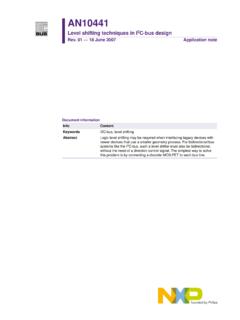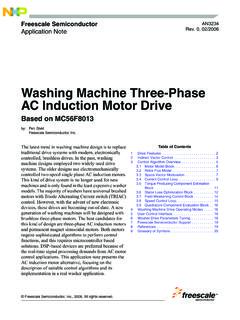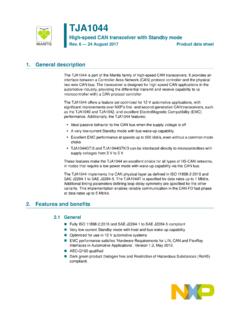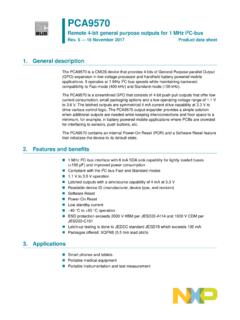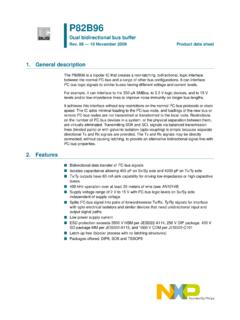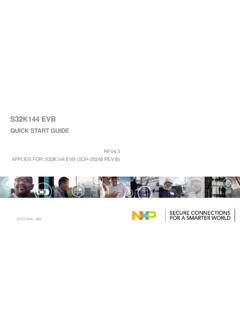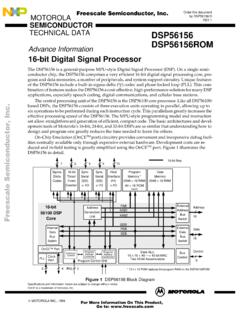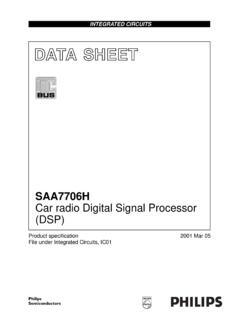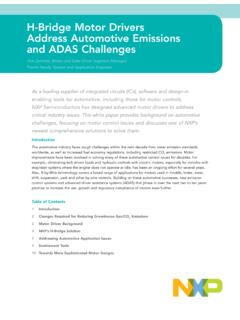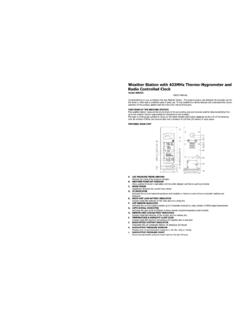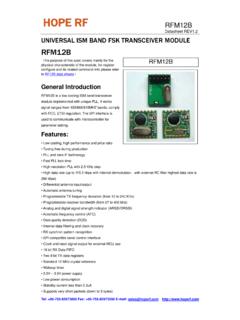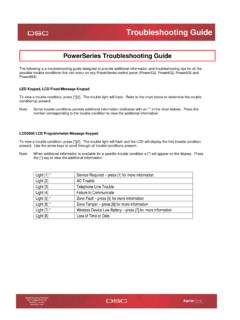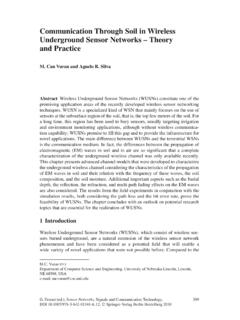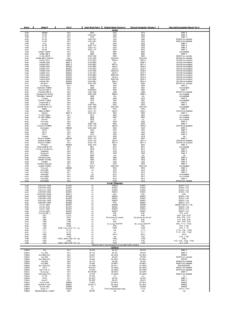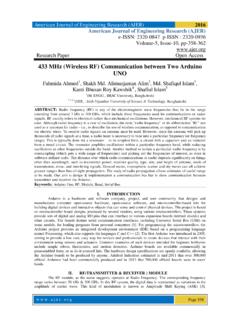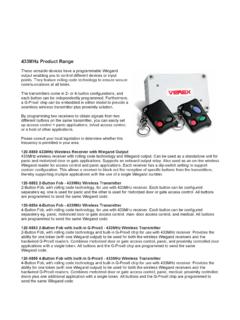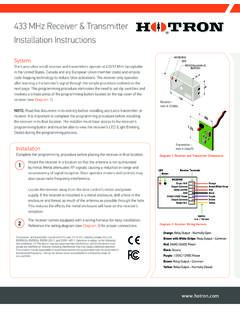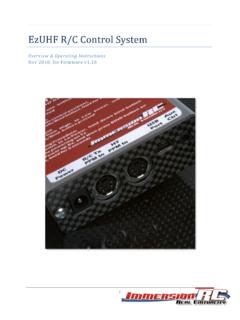Transcription of AN11443 BFU550XR ISM 433 MHz LNA design - nxp.com
1 AN11443 BFU550XR ISM 433 mhz LNA design Rev. 1 23 January 2014 Application note Document information Info Content Keywords BFU520, BFU530, BFU550 series, ISM-band, 433 mhz 866 MHz Abstract This document describes an ISM Frequency LNA design on BFU5xxXR Starter kit Ordering info BFU5xxXR Starter kit OM7964, 12nc 9340 678 73598 Contact information For more information, please visit: NXP Semiconductors AN11443 Example LNA design using BFU550XR AN11443 All information provided in this document is subject to legal disclaimers. NXP 2014. All rights reserved.
2 Application note Rev. 1 23 January 2014 2 of 25 Contact information For more information, please visit: For sales office addresses, please send an email to: Revision history Rev Date Description 1 20140123 First publication NXP Semiconductors AN11443 Example LNA design using BFU550XR AN11443 All information provided in this document is subject to legal disclaimers. NXP 2014. All rights reserved. Application note Rev. 1 23 January 2014 3 of 25 1. Abstract In this application note an ISM band (industrial, scientific and medical) LNA design (low noise amplifier) using a BFU5xx transistor from NXP latest wideband transistor range is described.
3 It shows the design , simulation and implementation phases. Together with measurement results, parameters measured over temperature are shown. The application note (AN) can be a starting point for new design (s), and/or derivative designs. 2. Introduction The BFU5xxXR transistor family is designed to meet the latest requirements on high frequency applications (up to approximately 2 GHz) such as communication, automotive and industrial equipment. As soon as fast, low noise analogue signal processing is required, combined with medium to high voltage swings the BFU5xxXR transistors are the perfect choice.
4 Due to the high gain at low supply current those types can also be applied very well in battery powered equipment. Compared to previous Philips / NXP transistor generations and competitor products improvements on gain, noise and thermal properties are realized. BFU5xxXR transistors are available in various packages. The transistors are promoted with a full promotion package, called starter kits (one kit type per package-type) . Those kits include two PCB s (one with grounded emitter, one with emitter degeneration provision), RF connectors, transistors and simulation model parameters required to perform simulations.
5 See the overview of available starter kits in the table below. Table 1. Customer evaluation kits Basic type Customer evaluation kits 1 BFU520W, BFU530W, BFU550W OM7960, starter kit for transistors in SOT323 package 2 BFU520A, BFU530A, BFU550A OM7961, starter kit for transistors in SOT23 package 3 BFU520, BFU530, BFU550 OM7962, starter kit for transistors in SOT143 package 4 BFU520X, BFU530X, BFU550X OM7963, starter kit for transistors in SOT143X package 5 BFU520XR, BFU530XR, BFU550XR OM7964, starter kit for transistors in SOT143XR package 6 BFU580Q, BFU590Q OM7965, starter kit for transistors in SOT89 package 7 BFU580G, BFU590G OM7966.
6 Starter kit for transistors in SOT223 package NXP Semiconductors AN11443 Example LNA design using BFU550XR AN11443 All information provided in this document is subject to legal disclaimers. NXP 2014. All rights reserved. Application note Rev. 1 23 January 2014 4 of 25 Basic type Customer evaluation kits Fig 1. BFU5xxXR evaluation boards 3. Requirements The demonstrator circuit is designed to show the BFU550XR capabilities for a 433 mhz ISM LNA with strong focus on best possible Noise Figure at low to medium supply current. The aim of the demonstrator circuit was to design a LNA optimized for the ISM band for battery powered equipment meet ing following requirements: Supply Voltage: Volts nominal Supply current: 20mA at ambient temperature Noise Figure: < Gain : approx.
7 13dB OIP3 : priority on NF but preferably >+20dBm Input Return-Loss: < - 8dB Output Return-Loss: < - 10dB The design is aimed at low BOM cost and small PCB area, inductors are SMD types (preferable low cost multilayer types) to enable simple tuning to other frequency bands. 4. design considerations In order to achieve minimum Noise Figure, with Gain still close to the maximum available gain, the source impedance has to be close to the optimum for Noise Figure and not too far from to the maximum gain impedance. Designing for optimum Noise Figure will compromise, for example, the input return loss, but this is assumed to be acceptable.
8 At any time the circuit should be stable, hence during the design phase the K-factor needs to be observed carefully. NXP Semiconductors AN11443 Example LNA design using BFU550XR AN11443 All information provided in this document is subject to legal disclaimers. NXP 2014. All rights reserved. Application note Rev. 1 23 January 2014 5 of 25 5. design approach The design starts in the simulation phase, applying the Mextram Model (available at ). Agilent Advanced design System (ADS) was used for this but other simulation software packages should give equal results. Spice / Gummel Poon models are available.
9 Once simulation results meet the requirements, the circuit is built on a universal Printed Circuit Board (PCB) and evaluated. If measurement results show significant offset from simulated results, fine tuning is required until required performance is met. To achieve better matching between simulations and measurements, the PCB parasitic properties were added in the simulation template. Following blocks of passive components can be identified: 1) resistors for DC biasing 2) passives set up collector load 3) passives for output matching 4) passives for input matching 5) passives required to ensure stable operation Eac h block will be discussed separately below.
10 Simulation steps Following simulation / design approach can be useful: 1) Configure the DC bias set-up, ensuring the Icc is set around desired value. 2) Configure the collector load circuit and output matching circuitry, optimizing the output Return Loss (RL). 3) Check stability. 4) Configure the input matching, for LNA optimize for minimum noise figure (NF) but keep close to optimum gain, if possible optimum NF gain points should be close. 5) C heck stability. Assumptions: - Reali stic passives are used by applying Murata design kit (0603 / 0402) - PCB tracks represented by strip-lines Implementation / evaluation steps Following implementation / evaluation steps have been executed: 1) Implement simulated design on universal PCB.
